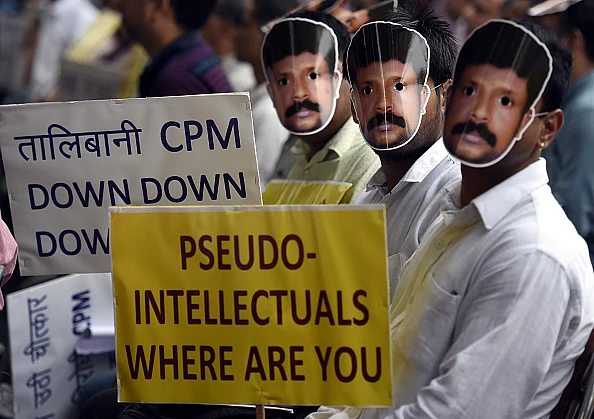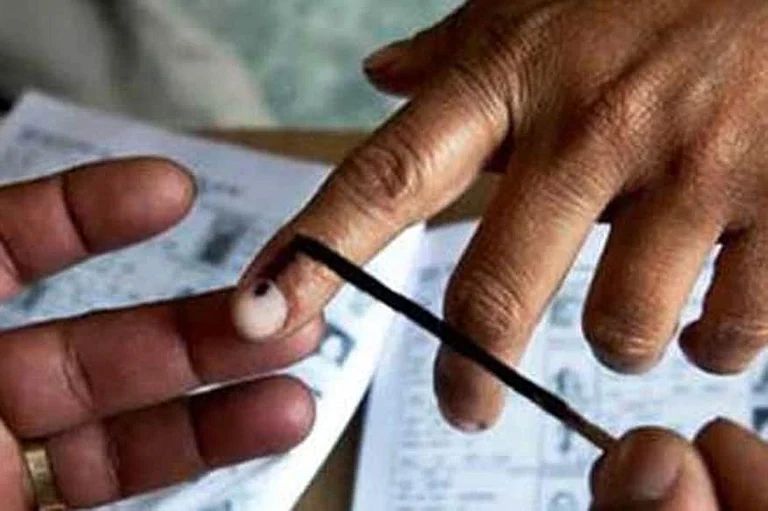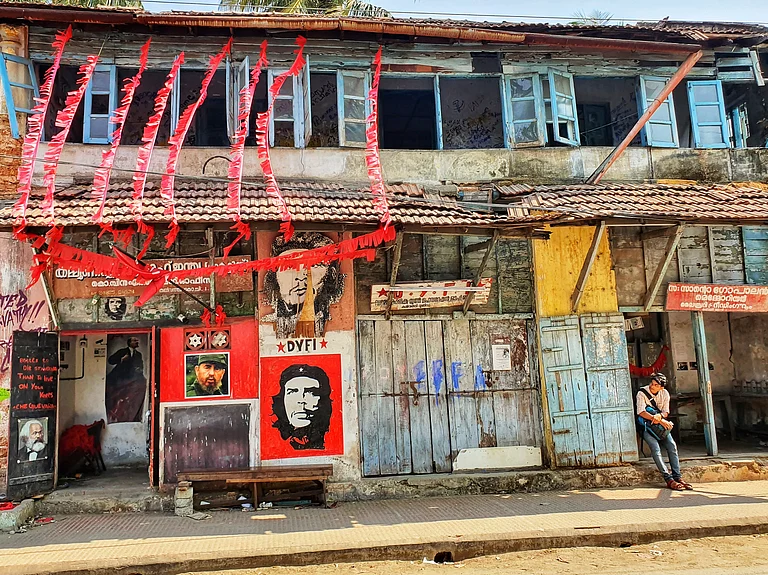At the Bhaskareeyam Convention Centre in Kaloor, Ernakulam, 15 persons, most of them senior citizens, gathered in a circular formation to discuss the importance of maintaining a healthy lifestyle.
Seated in an irregular padmasana, a Sanskrit shloka-reciting grey-haired man with a white beard leads the discussion. Commencing at 6:45 in the morning, his discourse marked the initiation of the daily morning shakha. Following an hour of customary rituals reaffirming the organisation’s allegiance to Hindutva values and underscoring the importance of physical fitness, three participants, all aged above 70, talked about the organisation’s activities in Kerala.
One of the shakha members, Ramesh, runs a grocery shop at Kaloor in Kochi and is 72-years-old. He was indoctrinated to Rashtriya Swayamsevak Sangh (RSS) at the age of 8. He concedes that the RSS has not attained the growth it should have achieved over the course of decades, primarily due to the presence of the Communist Party. Despite this, he expresses contentment and joy over the emergence of a “Hindu renaissance” in India. Dismissing claims of polarisation, he interprets the change as evidence of Hindu renaissance. Reservation to the backward communities and Dalits is another hindrance that prevents the growth of Hindutva, according to him.
But Rajesh Nair, a retired soldier, hurriedly tried to correct Ramesh, pointing out that the RSS is not against reservation. “They are also Hindus,” he said. Rajesh does not believe that Kerala is a state that has achieved progress in the human development index compared to many other States. “These are all tall claims; Uttar Pradesh also is a developed state; Kerala has its own fall-outs,” he argued.
The participants at the shakha, however, openly displayed a lack of interest in matters pertaining to elections. “It is their (BJP’s) business; Sangham will involve only when it is required,” says Sajeev, 60-year-old who is a full timer with the Sangh, in-charge of its umbrella organisation, ‘Arogya Bharati’.
Kerala is one of the states with the largest number of RSS shakhas. “It is still the same. Technically, it would not be correct because many other States like Maharashtra and Gujarat are not considered as a single State ; but still, Kerala is a state where Sangh enjoys strong presence,” says P N Easwar, Kerala’s RSS state chief. According to Easwar, there are a little over 3,000 shakhas in Kerala. But the data concerning the RSS is often elusive. A 2017 report by The Times of India indicated that the RSS had 5,000 shakhas in the southern state. Easwar neither affirmed nor refuted this, opting instead to evade the question by suggesting, “There may be more.”
The organisational structure of the RSS remains largely unknown to the public, as the organisation tends to keep such information away from the limelight. Even Easwar was unable to explain the historical context of the evolution of the geographical divisions within the Sangh. He also does not know why the Sangh has 52 states, instead of the officially recognised 28 states and eight union territories. According to Walter K. Anderson, an American scholar who studies the RSS, the organisation has a multi-layered organisational structure. There are 11 regions which are referred to as Kshetra by the Sangh and 52 States (Prants). It is further divided into Vibhag (grouping of Districts), Zilla (district) Nagar (city) Mandal (10 or more shakhas) and shakha (local unit). As explained in Anderson’s book, ‘The RSS- A View to the Inside’, there are two top level committees that control the entire activity of the Sangh. They are the Akhil Bharatiya Karyakari Mandal (Central Executive Committee) consisting of around fifty members and the Akhil Bharatiya Prathinidhi Sabha (General Assembly), a body consisting around 1,400 delegates.
However, Ernakulam’s 'Bhaskareeyam Convention Centre', the state RSS headquarters, remains bustling with visitors. Pracharaks from various districts often gather there to coordinate activities for umbrella organisations like Seva Bharati, Kshethra Samraksha Samiti, Arogya Bharati, Vidya Bharati, etc. Additionally, the Saraswathy Vidyanikethan Public School within the premises, managed by the Rashtra Dharma Parishad Trust, hosts the daily morning shakha, making it a unique setting not associated with a temple.
Leaders of the RSS in Kerala typically sidestep questions regarding their association with the BJP. Allegedly, the RSS expresses dissatisfaction with the ‘financial dealings’ of the Kerala BJP, citing numerous accusations of financial misconduct and hawala transactions against BJP leaders in the state. While the RSS traditionally plays a pivotal role in overseeing and orchestrating the electoral process in the state, media reports suggest that the organisation has yet to assume a leadership role in the upcoming election. Easwar openly conveyed his reluctance to delve further into discussions about the relationship with the BJP, asserting, “We are not directly involved in matters related to the election. We would act when it is required,” he insisted. Despite this reluctance, it is widely acknowledged that the central leadership of the BJP relies on the RSS for insights into party affairs, particularly during conflicts and significant decision-making processes.
The members of the morning shakha RSS headquarters unanimously view the powerful presence of CPI (M) as the biggest challenge to the Sangh’s growth. They also identify the political and economic power of minority communities in Kerala as another hindrance to the RSS’s expansion. The longstanding conflict between CPI (M) and RSS, which predates the formation of the state in 1956, intensified in the 1980s, leading to a series of deadly clashes. With the emergence of the BJP as a dominant national party, the violence escalated further. Over the past decade, approximately 102 people have lost their lives in political violence involving BJP/RSS, SDPI , Congress, and CPI (M). RSS launched a nationwide campaign highlighting the ‘killing fields of Kerala,’ prompting strong reactions from its national leaders. Kundan Chandrawat, an RSS leader from Madhya Pradesh, even announced a one crore rupee reward for the head of Chief Minister Pinarayi Vijayan, resulting in a police case against him.
On the opposing front, the CPI (M) has launched an assertive campaign against the RSS, contending that violence is intrinsic to the Sangh’s DNA. In a 2016 article for People’s Democracy, Sitaram Yechuri argued that “the terror experiment practiced by the RSS in Kerala is part and parcel of their fascist agenda of converting the secular democratic republic into a theocratic state.” Since assuming power for the second consecutive term, the party has consciously opted to abstain from retaliatory measures. According to KT Kunjikkannan, a district committee member of CPI (M) in Kozhikkodu, over fifty CPI (M) activists have been killed from 2011 to 2020. He asserts, “The accused in around 76 cases of murder are from RSS/BJP, Congress and SDPI.”
In a recent development, the Kerala government prohibited mass drills organised by the RSS in temples managed by Devaswom Boards. The majority of temples in Kerala fall under Devaswom Boards, including Travancore, Cochin, Malabar and Guruvayur Devaswom Boards. While this restriction already existed, the Travancore Devaswom Board issued a fresh order in September 2023, specifically banning mass drills in temples.
Through its various umbrella organisations, the RSS has been strategically penetrating the cultural landscape of Kerala, consistently posing a challenge to leftist ideologies. Among the approximately 11 umbrella organisations, the Kshethra Samrakshana Samiti (KSS) stands out as the most prominent, active and dynamic. Over the past two decades, temples have evolved into the focal point for political and cultural activities orchestrated by the Sangh in Kerala. As a counter, the CPI (M), has actively endeavoured to make inroads into the ‘temple constituency’ by deploying party members in temple committees and associated activities. Ironically, the prototype of the Kshethra Samrakshana Samiti of the RSS was initiated by freedom fighter and former Indian National Congress leader K. Kelappan. According to OB Roopesh, a social science scholar specialising in research on the growth of Hindutva in Kerala, Kelappan established the ‘Malabar Kshethra Samrakshana Samiti’ in 1967. This was later transformed into the Kshetra Samrakshana Samiti at the initiative of P. Madhavan, the then leader of the RSS. Furthermore, P. Madhavan also founded the ‘Tantra Vidya Peedam,’ an educational institution exclusively meant for young Brahmins and focused on tantric practices.
RSS’s growing influence in the cultural domain of Kerala, however, has not translated into electoral success, as evident from the voting data. The BJP remains confined to 12 to 15 percent of votes polled in the state, with no representation in the legislative assembly. Nevertheless, scholars and political commentators contend that this should not diminish the significance of the considerable rise of ultra-right-wing culture and neo-conservatism within the society.
“This scenario of the rise of the ultra-right in the state could best be explained by the structural changes in the composition of its middle class on the one hand, and the increasing frustration amongst the lower-middle class and others on the other, especially Dalits and Adivasis. The structural changes have been caused by a substantial increase in the number of people among the lower-middle class who have been adversely affected and experience a multitude of social risks caused by shrinking employment opportunities, unfavourable market conditions and dwindling agricultural prospects,” observes Professor KM Seethi, former director of the School of International Relations and Politics, Mahatma Gandhi University, in an article in Economic and Political Weekly in July 2017.
However, the RSS in Kerala is quite confident about grabbing power someday in the southern state. “RSS is capable of removing the hurdles in our way,” an RSS leader on condition of anonymity said, hinting at their differences with the State unit of the BJP. According to him, the BJP in Kerala lacks visionary leadership and corruption has become an evil in the party, weakening it from the inside.
Kerala’s Left, too, is currently grappling with an evident ideological crisis. Organisations within the Sangh Parivar are strategically working to reintroduce and popularise age-old practices such as yaga (or yagna). “In temples, they conduct daily spiritual talks that significantly attract a rural audience, especially women. All these speakers are RSS affiliates who subtly promote their ideology under the guise of spiritual discussions. We are often perplexed about how to address this situation,” says a CPI (M) activist in Thalassery, Kannur. He recounted a recent Somayaga organised by the RSS in a nearby temple, wherein even women from CPI (M) families participated. Expressing a sense of helplessness in dealing with such situations, he underscores the challenge of convincing people about the hidden agenda behind these temple-related activities orchestrated by the Sangh Parivar.
Recently, a lower primary school in Calicut caught attention for its attempt to conduct a Hindu ritual, a ‘homam,’ as part of the inauguration of a new building. Local CPI (M) activists intervened, raising protests and prompting the Sangh Parivar activists to abandon their attempt. According to KT Kunjikkannan, the RSS has been actively working since the 1980s to revive an archaic Hindutva culture. “They recognise that divisive tactics used in other states would not be as effective in Kerala, given it being an informed society. Hence, they have decided to revitalise Hindutva culture through rituals such as yagas. The first such yaga was organised in Thiruvananthapuram in the 1980s to address drought,” he recalled. The Puthra Kameshti Yaga in the early nineties, aimed at birthing ‘good sons,’ triggered widespread protests from women’s organisations in Kerala. This event marked the emergence of feminist collectives across the state.
Despite this, the RSS, through its umbrella organisations, has gradually and successfully infiltrated the cultural landscape of Kerala. Over the past two decades, yagas and spiritual lectures in temples have become common and normalised in rural Kerala, attracting limited media attention. In Kerala’s cultural and political milieu, the RSS becomes visible primarily during political tensions and ensuing violence. Conversely, its cultural interventions often go unnoticed and are subsequently normalised, gradually eroding the secular and liberal ethos that Kerala has cultivated over centuries, according to the Sangh’s critics.





























